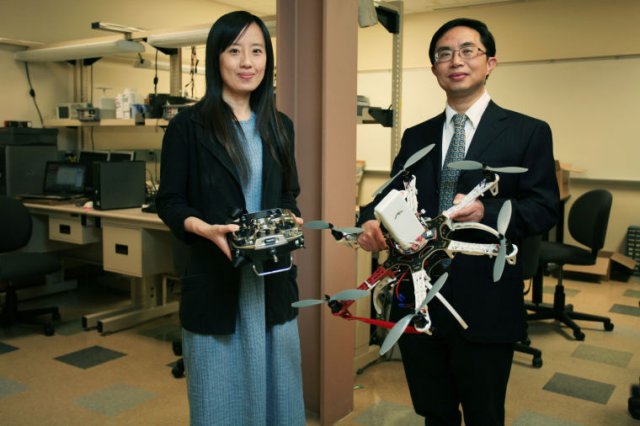A small UAS built at the University of North Texas could eventually be the key to improved communications at a major disaster.Two UNT professors, Yan Wan and Shengli Fu, developed a UAS that disperses a Wi-Fi signal that could improve communications for first responders and victims at the centre of a disaster.
The development is just one piece of a Smart Emergency Response System that the professors are working on with other academics and industry leaders across the country as part of a White House Presidential Innovation Fellow project.
Other projects completed within the system include human-operated robots that could act as first responders, trained search-and-rescue dogs and a control center base. When used together, the pieces create a communications infrastructure that will improve response to emergencies, said Wan, an assistant professor of electrical engineering.
“Communication infrastructure is the basis for the success with coordination of the rescue teams, and the dissemination of information to all of the people on the scene,” she said. “All of this requires robust infrastructure, and when this infrastructure performance isn’t good or doesn’t exist in an emergency scenario, it becomes a big problem, so we are trying to provide on-demand communication infrastructure to help with post-emergency response.”
The pair joined the other researchers in the project for a demonstration Tuesday at the University of Washington in Seattle.
“The event in Seattle is kind of the first-time integration because we will have the other teams, and we want to put all of the different technology together for a big, integrated project,” said Fu, an associate professor of electrical engineering at UNT.
The two professors worked to develop the Wi-Fi-enabled drone since December with the help of some students, with Wan working on the theoretical mobility of the drones and the control, and Fu focusing on the communication aspects.
After the projects are coordinated in Washington, the teams of researchers will have until June 11 to tweak the projects before the presentation for the SmartAmerica Challenge Expo in Washington, D.C. The expo will feature the response system, and other researchers and companies that work on similar projects.
After the expo, they plan to continue research but also will work on figuring out the practical applications for the developments. Drones are a big topic of debate, both researchers explained, and with current Federal Aviation Administration and Federal Communications Commission guidelines, there are several potential issues with the Wi-Fi drones.
This means the drones probably won’t be used in the next major disaster, but with continued work and updates to FCC and FAA policies on drones, there’s a lot of research that can be conducted before they are put to use in actual emergencies, the professors said.
“There are some concerns, but I think the real revelation is for the academic industry,” Fu said.
Photo: David Minton | Denton Record-Chronicle
Source: KHD News

